初中英语精华笔记大全(1)
【最新推荐】初中英语笔记(精华版) (1)
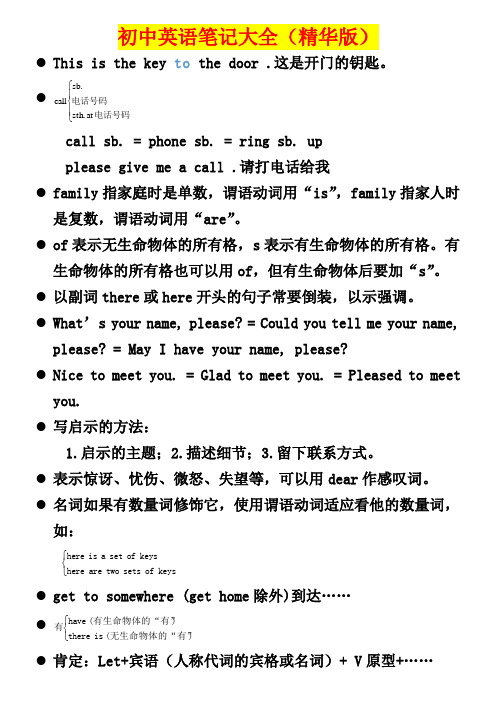
初中英语笔记大全(精华版)● This is the key to the door .这是开门的钥匙。
● ⎪⎩⎪⎨⎧电话号码电话号码at .sth .sb call call sb. = phone sb. = ring sb. upplease give me a call .请打电话给我● family 指家庭时是单数,谓语动词用“is ”,family 指家人时是复数,谓语动词用“are ”。
● of 表示无生命物体的所有格,s 表示有生命物体的所有格。
有生命物体的所有格也可以用of ,但有生命物体后要加“s ”。
● 以副词there 或here 开头的句子常要倒装,以示强调。
● What’s your name, please? = Could you tell me your name, please? = May I have your name, please?● Nice to meet you. = Glad to meet you. = Pleased to meet you.● 写启示的方法:1.启示的主题;2.描述细节;3.留下联系方式。
● 表示惊讶、忧伤、微怒、失望等,可以用dear 作感叹词。
● 名词如果有数量词修饰它,使用谓语动词适应看他的数量词,如:● get to somewhere (get home 除外)到达……● ● 肯定:Let+宾语(人称代词的宾格或名词)+ V 原型+…… ⎩⎨⎧ keys of sets two are here keys of set a is here ⎩⎨⎧)无生命物体的“有”(is there )有生命物体的“有”( have 有否定:Don’t let +宾语+V 原型+……/Let + 宾语 + not + V 原型+……● have 表示“有”时才可以用来提问或写成否定“haven’t”。
● ●● 反身代词:myself (我自己) yourself (你自己) himself (他自己) herself (她自己) itself (它自己) ourselves (我们自己) yourselves (你们自己) themselves (他们自己)● How much + be + 商品?(答:It’s/They’re……) = What is the price of ……?(答:It ’s ……)● cent 美分 One dollar =100 cents● other(两者中的另一个) another (三者中的另一个)● 越接近物品本身性质的形容词越靠近物品,如:big blue hat ● 帮助某人做某事help sb. (to) do sth.help sb. with sth.with the help (n.) of sb. e.g. He studies math well, with ⎩⎨⎧⋯⋯⋯⋯? you will 问: )听话的人include 不(us Let ? we shall 问: )说话的人和听话的人(include s Let'the help of teacher.●一般将来时的一般形式:主语+will+动词原形+……●Can I help you? = What can I do for you? = (Is there)anything I can do for you?●●be动词不加动词原形●“hundred,thousand”与基数词一起表示具体数字时不加“s”。
初中三年精华英语笔记

初中三年精华英语笔记今天为大家分享的是初中英语学习笔记大全,涵盖了初中三年考点,按字母顺序排列,方便大家查看,大家一定要好好利用这份资料~A1 (see 、hear 、notice 、find 、feel 、listen to 、look at (感官动词)+doeg:I like watching monkeys jump.2 (比较级+ and + 比较级)表示越来越怎么样3 a piece of cake =easy 小菜一碟(容易)4 agree with sb 赞成某人5 all kinds of 各种各样a kind of 一样6 all over the world = the whole world整个世界7 along with同……一道,伴随……eg : I will go along with you.我将和你一起去8 As soon as 一怎么样就怎么样9 as you can see 你是知道的10 ask for……求助, 向…要…(直接接想要的东西)11 ask sb for sth 向某人什么12 ask sb to do sth 让某人某事ask sb not to do 叫某人不要做某事13 at the age of 在……岁时eg:I am sixteen .I am at the age of sixteen.14 at the beginning of …………的起初;……的开始15 at the end of +地点/+时间:最后,尽头,末尾.eg : At the end of the day.16 at this time of year 在每年的这个时候B17 be /feel confident of sth /that clause +从句感觉/对什么有信心,自信eg : I am / feel confident of my spoken English I feel that I can pass the test.18 be + doing :1 现在进行时 2 将来时19 be able to (+ v 原) = can (+ v 原)能够……eg : She is able to sing She can sing.20 be able to do sth 能够干什么eg :she is able to sing.21 be afraid to do (of sth 恐惧,害怕……eg : I'm afraid to go out at night .22 be allowed to do 被允许做什么eg: I'm allowed to watch TV. 我被允许看电视I should be allowed to watch TV. 我应该被允许看电视23 be angry with sb 生某人的气eg : Don't be angry with me24 be angry with(at) sb for doing sth 为什么而生某人的气25 be as…原级…as和什么一样eg : She is as tall as me 她和我一样高26 be ashamed to27 be away from 远离28 be away from 从……离开29 be bad for 对什么有害eg : Reading books in the sun is bad for your eyes.在太阳下看书对你的眼睛不好30 be born 出生于31 be busy doing sth 忙于做什么事be busy with sth 忙于……32 be careful 当心;小心33 be different from……和什么不一样34 be famous for 以……著名35 be friendly to sb 对某人友好36 be from = come from 来自eg :He is from Bejing .He comes from Bejing .Is he from Bejing ?Does he come from Bejing ?37 be full of 装满……的be filled with 充满eg: The glass is full of water .The glass is filled with water .38 be glad+to+do/从句39 be going to + v(原)将来时40 be good at(+doing) = do well in在某方面善长, 善于……41 be good for 对什么有好处eg : Reading aloud is good for your English.42 be happy to do 很高兴做某事43 be helpful to sb 对某人有好处eg : Reading aloud is helpful to you . Exercising is helpful to your bady .44 be in good health 身体健康45 be in trouble 处于困难中eg : She is in trouble.46 be interested in 对某方面感兴趣47 be late for = come late to 迟到eg: Be late for class 上课迟到48 be like 像……eg : I'm like my mother49 be mad at 生某人的气50 be made from 由……制成(制成以后看不见原材料)51 be made of 由……制成(制成以后还看得见原材料)52 be not sure 表不确定53 be on a visit to 参观54 be popular with sb 受某人欢迎55 be quiet 安静56 be short for 表**的缩写eg: 陶is short for 陶俊杰57 be sick in bed 生病在床58 be sorry to do sth / be sorry for sb 对...感到抱歉eg : I am sorry for you .59 be sorry to hear that 很抱歉听到...(消息)60 be sorry to trouble sb 很抱歉打扰61 be strict in doing sth 严于做某事eg : He's strict in obeying noles.62 be strict with sb 对某人要求严格eg: Some students are not strict with themselves. 有些学生对自己不严格63 be strict with sb in sth 某方面对某人严格64 be supposed to do 被要求干什么65 be sure 表确定66 be sure of doing sth 对做某事有信心eg: He is sure of winning I am sure of learning English well.67 be sure of sth 对做某事有信心eg: I'm sure of my head /my teacher. 我相信我的大脑(老师)68 be sure that sth 对做某事有信心eg: I'm suer that he can pass the test.69 be sure to do sth一定会做某事eg: We are sure to pass the test. 我们一定会通过这次考试Weare sure to learn English well. 我们一定能学好英语70 be terrified of + 名/动doing 害怕……71 be terrified to do sth 害怕做某事72 be the same as …和什么一样73 be used to doing sth 习惯做某事eg: My father is used to getting up early.我爸爸习惯早起。
初中英语笔记大全(超级精华版)
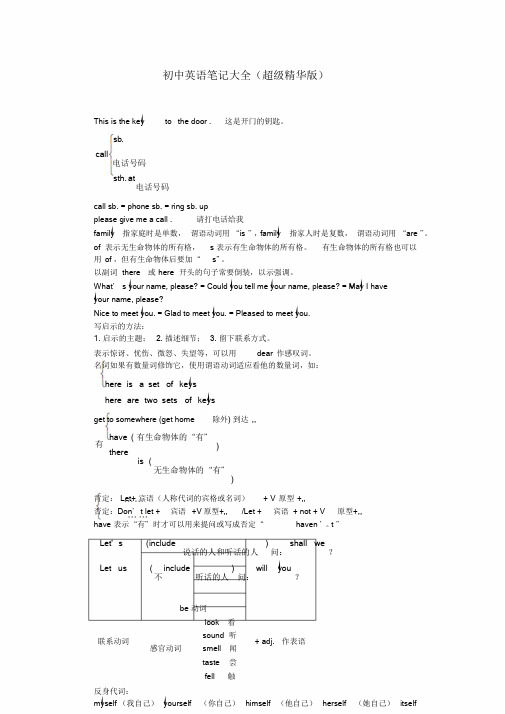
初中英语笔记大全(超级精华版)This is the key to the door . 这是开门的钥匙。
sb.call电话号码sth. at电话号码call sb. = phone sb. = ring sb. upplease give me a call . 请打电话给我family 指家庭时是单数,谓语动词用“is ”,family 指家人时是复数,谓语动词用“are ”。
of 表示无生命物体的所有格,s 表示有生命物体的所有格。
有生命物体的所有格也可以用of ,但有生命物体后要加“s”。
以副词there 或here 开头的句子常要倒装,以示强调。
What’s your name, please? = Could you tell me your name, please? = May I haveyour name, please?Nice to meet you. = Glad to meet you. = Pleased to meet you.写启示的方法:1. 启示的主题;2. 描述细节;3. 留下联系方式。
表示惊讶、忧伤、微怒、失望等,可以用dear 作感叹词。
名词如果有数量词修饰它,使用谓语动词适应看他的数量词,如:here is a set of keyshere are two sets of keysget to somewhere (get home 除外) 到达,,有h avethere ( 有生命物体的“有”)is (无生命物体的“有”)肯定:Let+ 宾语(人称代词的宾格或名词)+ V 原型+,,否定:Don’t let + 宾语+V 原型+,, /Let + 宾语+ not + V 原型+,, have 表示“有”时才可以用来提问或写成否定“haven ’。
t ”Let' s (include ) shall we说话的人和听话的人问:?Let us ( include ) will you不听话的人问:?be 动词look 看联系动词感官动词s ound 听smell 闻+ adj. 作表语1(它自己)ourselves (我们自己)yourselves (你们自己)themselves (他们自己)How much + be + 商品?(答:It ’s/They ’re,, )= What is the price of ,, ?(答:It ’s,, )cent 美分One dollar =100 centsother( 两者中的另一个) another (三者中的另一个)越接近物品本身性质的形容词越靠近物品,如:big blue hat帮助某人做某事help sb. (to) do sth.help sb. with sth.with the help (n.) of sb. e.g. He studies math well, with the help of teacher.一般将来时的一般形式:主语+will+ 动词原形+,,Can I help you? = What can I do for you? = (Is there) anything I can do for you?a. 受欢迎的welcome v. 欢迎n. 欢迎get a warm welcome 得到热烈欢迎be 动词不加动词原形“hundred ,thousand ”与基数词一起表示具体数字时不加“s”。
初中英语语法精华笔记大全

1、可数名词是指表示人或事物,可以用数来计量的名词,有单复数之分。如:glass-----glasses; book---- books
2、不可数名词是指所表示的事物不能用数来计量。
如:paper, rice, water , milk, tea等。
3、有些名词在特定情况下由不可数变为可数名词。
I have been waiting for an hour.
He is an honest young fellow.
A hammer is a useful fool.
二、冠词的定义
冠词是置于名词之前,说明名词所表示的人或事物的一种虚词,它不能离开名词而单独存在。冠词有两种:
一种是定冠词(the Definite Article);the
一种是不定冠词(the Indefinite Article). a an
三、不定冠词的用法
a用于辅音音素起首的单词前,an用于元音音素起首的单词前。
1、当第一次提到某人或某物时,用a或an起介绍作用,如:
What is this?It is a bus.
Who is she?She is a doctor.
2、表示泛指一类人或物
A snake is a cold-blood animal.
A plane is a machine that can fly.
以O结尾的名词
potatoes; tomatoes;photos; kilos; bamboos; radios
2、少数名词有不规则的变化形式
policeman---policemen; man---men; woman---women;
tooth---teeth; foot---feet; sheep---sheep; deer---deer;
初中生英语笔记

初中生英语笔记一、词汇。
1. 名词。
- 可数名词复数变化规则。
- 一般情况加 -s,如book - books,pen - pens。
- 以s,x,ch,sh结尾的加 -es,如bus - buses,box - boxes,watch - watches,dish - dishes。
- 以辅音字母+y结尾的,变y为i加 -es,如baby - babies,city - cities。
- 以f或fe结尾的,变f或fe为v加 -es,如knife - knives,leaf - leaves(但也有一些直接加 -s的,如roof - roofs)。
- 不可数名词。
- 常见的不可数名词有water,milk,bread,paper等。
它们没有复数形式,表达数量时可以用a piece of,a glass of等短语,如a piece of paper,a glass of water。
2. 动词。
- 动词的第三人称单数形式。
- 规则变化与可数名词复数变化规则类似。
一般情况加 -s,如like - likes;以s,x,ch,sh,o结尾的加 -es,如go - goes,do - does;以辅音字母+y结尾的,变y为i加 -es,如fly - flies。
- 动词的时态。
- 一般现在时。
- 表示经常或习惯性的动作或状态。
结构:主语+动词原形(主语为第三人称单数时,动词用第三人称单数形式)。
例如:I often play football. He often plays football.- 现在进行时。
- 表示正在进行的动作。
结构:be动词(am/is/are)+动词的 -ing形式。
例如:I am reading a book. They are playing games.- 一般过去时。
- 表示过去某个时间发生的动作或存在的状态。
规则动词过去式一般在词尾加 -ed,如play - played,work - worked;不规则动词有特殊的过去式形式,如go - went,have - had。
初一英语读书笔记大全

初一英语读书笔记大全【篇一:初一英语读书笔记】初一英语读书笔记 1.这个经常下雨。
(两种)there is often rain./it often rains here.2.我们很惊讶地在火车站看到西蒙。
we are surprised to see simon at the train station.3.沿着这条路走,到红绿灯处,你就会看到那撞楼。
go along this street to the traffic light,then you will see that building.4.老师来了,请停止讲话。
here comes the teacher,please stop talking.5.三个穿警察制服的人从车里出来。
three man in police uniform get out of the car.6.突然一个大个子把他推进了厢式货车的后面。
suddenly a tall man pull him into the back of the van.7.杰尔现在坐在我左边。
jill is sitting on my left now.8.在一字路口向右转,你会发现入口处就在你前面。
turn right to the cross, and you will find the entrance before yourself.9.这个强盗从大厦跑了出去。
this robber runs out of the building.10.我们走不同的路线好吗?shall we take different routes?11.一个穿红色衣服的女孩站在街道的拐弯处。
a girl in red is standing at the corner of the street.12.当交通灯是红色是不能过马路。
you cant go across the road when the traffic light is red.13.学英语不是很难。
初中英语学习笔记大全
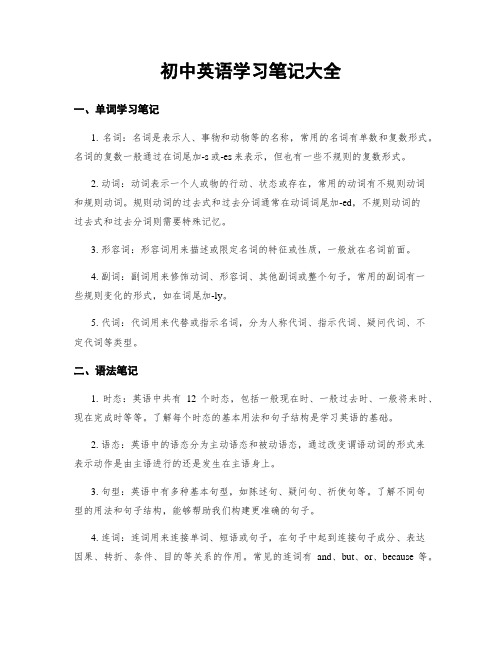
初中英语学习笔记大全一、单词学习笔记1. 名词:名词是表示人、事物和动物等的名称,常用的名词有单数和复数形式。
名词的复数一般通过在词尾加-s或-es来表示,但也有一些不规则的复数形式。
2. 动词:动词表示一个人或物的行动、状态或存在,常用的动词有不规则动词和规则动词。
规则动词的过去式和过去分词通常在动词词尾加-ed,不规则动词的过去式和过去分词则需要特殊记忆。
3. 形容词:形容词用来描述或限定名词的特征或性质,一般放在名词前面。
4. 副词:副词用来修饰动词、形容词、其他副词或整个句子,常用的副词有一些规则变化的形式,如在词尾加-ly。
5. 代词:代词用来代替或指示名词,分为人称代词、指示代词、疑问代词、不定代词等类型。
二、语法笔记1. 时态:英语中共有12个时态,包括一般现在时、一般过去时、一般将来时、现在完成时等等。
了解每个时态的基本用法和句子结构是学习英语的基础。
2. 语态:英语中的语态分为主动语态和被动语态,通过改变谓语动词的形式来表示动作是由主语进行的还是发生在主语身上。
3. 句型:英语中有多种基本句型,如陈述句、疑问句、祈使句等。
了解不同句型的用法和句子结构,能够帮助我们构建更准确的句子。
4. 连词:连词用来连接单词、短语或句子,在句子中起到连接句子成分、表达因果、转折、条件、目的等关系的作用。
常见的连词有and、but、or、because等。
三、阅读理解笔记1. 主旨大意:阅读理解题中常会涉及到文章的主旨大意,即整个文章的中心思想或主题。
可以通过阅读文章的标题、首段和结尾段来获取主旨大意。
2. 细节理解:阅读理解题中常会涉及到细节理解,即根据文章中的具体信息来回答问题。
在解答细节理解题时,需要仔细阅读相关段落,并在文章中找到相应的信息。
3. 推理判断:阅读理解题中常会涉及到推理判断,即根据文章中的暗示或提示进行推理。
在解答推理判断题时,需要将文章中的信息进行合理的推断。
4. 标题选择:阅读理解题中常会涉及到标题选择,即根据文章的内容选择一个合适的标题。
最新初中英语笔记大全(超级精华版)word版本

be afraid of doing sth. / be afraid of sth.害怕做某事/某物
be fond of = like
make a continuation to sth.对……有贡献
do well in = be good at擅长……
sport用来修饰名词要变为sports。
play + the +乐器Erhu除外
be动词后叫表语,修饰名词叫定语,修饰动词叫状语,前后两词对等叫同位语。
人民币和日元变复数不变,其他要。
be good with sb. = get on well with sb.与某人相处的很好
问:How often does Rick run on weekend?
Nice to meet you. = Glad to meet you. = Pleased to meet you.
写启示的方法:
1.启示的主题;2.描述细节;3.留下联系方式。
表示惊讶、忧伤、微怒、失望等,可以用dear作感叹词。
名词如果有数量词修饰它,使用谓语动词适应看他的数量词,如:
get to somewhere (get home除外)到达……
Thanks. / Thank you. / Thank you very much. / Thank a lot. / Many thanks.
You are welcome. / That’s OK. / That’s all right.
It’s my pleasure. / With pleasure.(这是我的荣幸。)
from the beginning开始时
2024年初一英语笔记
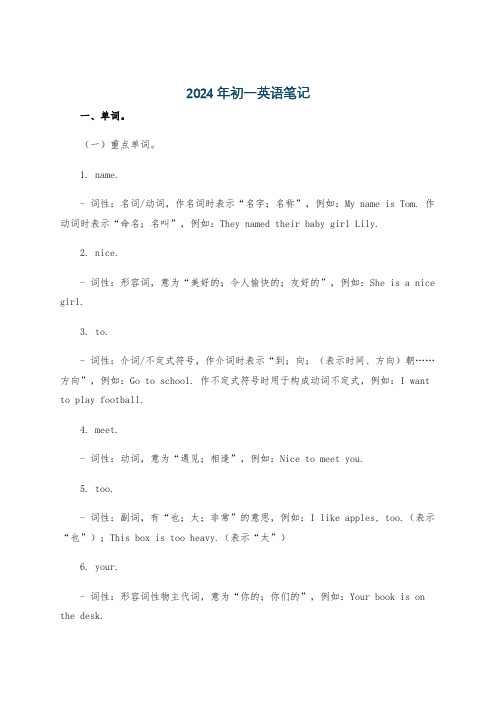
2024年初一英语笔记一、单词。
(一)重点单词。
1. name.- 词性:名词/动词,作名词时表示“名字;名称”,例如:My name is Tom. 作动词时表示“命名;名叫”,例如:They named their baby girl Lily.2. nice.- 词性:形容词,意为“美好的;令人愉快的;友好的”,例如:She is a nice girl.3. to.- 词性:介词/不定式符号,作介词时表示“到;向;(表示时间、方向)朝……方向”,例如:Go to school. 作不定式符号时用于构成动词不定式,例如:I want to play football.4. meet.- 词性:动词,意为“遇见;相逢”,例如:Nice to meet you.5. too.- 词性:副词,有“也;太;非常”的意思,例如:I like apples, too.(表示“也”);This box is too heavy.(表示“太”)6. your.- 词性:形容词性物主代词,意为“你的;你们的”,例如:Your book is on the desk.(二)单词记忆方法。
1. 联想法。
- 对于“name”这个单词,可以联想一个有名字的人或者事物,比如名人的名字。
像“Taylor Swift”,她的名字全世界很多人都知道,这样就容易记住“name”这个单词的含义。
2. 对比记忆法。
- 对比“too”和“to”。
“too”有“也”的意思,在句子中经常用于句末,而“to”更多的是表示方向或者用于构成不定式。
例如:I go to school.(“to”表示方向),I like music, too.(“too”表示“也”)二、短语。
1. nice to meet you.- 用法:用于初次见面时的问候语,回答通常是“Nice to meet you, too.”- 例句:A: Nice to meet you. B: Nice to meet you, too.2. be from.- 用法:表示“来自……”,后面接地点名词。
初中英语笔记(精华版)
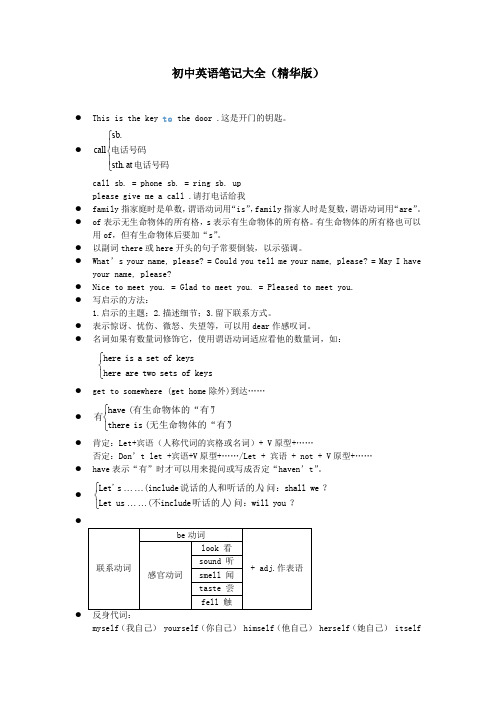
初中英语笔记大全(精华版)● This is the key to the door .这是开门的钥匙。
● ⎪⎩⎪⎨⎧电话号码电话号码at .sth .sb call call sb. = phone sb. = ring sb. upplease give me a call .请打电话给我● family 指家庭时是单数,谓语动词用“is ”,family 指家人时是复数,谓语动词用“are ”。
● of 表示无生命物体的所有格,s 表示有生命物体的所有格。
有生命物体的所有格也可以用of ,但有生命物体后要加“s ”。
● 以副词there 或here 开头的句子常要倒装,以示强调。
● What’s your name, please? = Could you tell me your name, please? = May I have your name, please?● Nice to meet you. = Glad to meet you. = Pleased to meet you.● 写启示的方法:1.启示的主题;2.描述细节;3.留下联系方式。
● 表示惊讶、忧伤、微怒、失望等,可以用dear 作感叹词。
● 名词如果有数量词修饰它,使用谓语动词适应看他的数量词,如:⎩⎨⎧ keys of sets two are here keysof set a is here● get to somewhere (get home 除外)到达……● ⎩⎨⎧)无生命物体的“有”( is there )有生命物体的“有”( have 有 ● 肯定:Let+宾语(人称代词的宾格或名词)+ V 原型+……否定:Don’t let +宾语+V 原型+……/Let + 宾语 + not + V 原型+……● have 表示“有”时才可以用来提问或写成否定“haven’t”。
● ⎩⎨⎧⋯⋯⋯⋯? you will 问: )听话的人include 不(us Let ? we shall 问: )说话的人和听话的人(include s Let' ●● myself (我自己) yourself (你自己) himself (他自己) herself (她自己) itself(它自己) ourselves(我们自己) yourselves(你们自己) themselves(他们自己)●How much + be + 商品?(答:It’s/They’re……) = What is the price of……?(答:It ’s……)●cent 美分 One dollar =100 cents●other(两者中的另一个) another(三者中的另一个)●越接近物品本身性质的形容词越靠近物品,如:big blue hat●帮助某人做某事help sb. (to) do sth.help sb. with sth.with the help (n.) of sb. e.g. He studies math well, with the help of teacher.●一般将来时的一般形式:主语+will+动词原形+……●Can I help you? = What can I do for you? = (Is there) anything I can do for you? ●●●“hundred,thousand”与基数词一起表示具体数字时不加“s”。
初中英语笔记大全 (超级精华版)
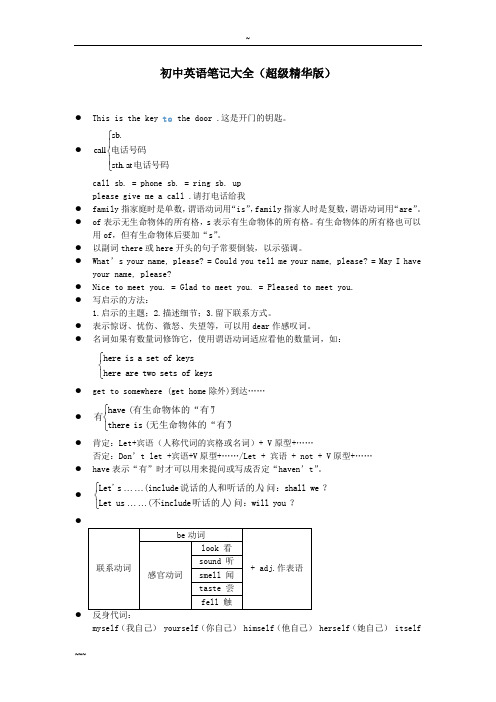
初中英语笔记大全(超级精华版)● This is the key to the door .这是开门的钥匙。
● ⎪⎩⎪⎨⎧电话号码电话号码at .sth .sb callcall sb. = phone sb. = ring sb. upplease give me a call .请打电话给我● family 指家庭时是单数,谓语动词用“is ”,family 指家人时是复数,谓语动词用“are ”。
● of 表示无生命物体的所有格,s 表示有生命物体的所有格。
有生命物体的所有格也可以用of ,但有生命物体后要加“s ”。
● 以副词there 或here 开头的句子常要倒装,以示强调。
● What’s your name, please? = Could you tell me your name, please? = May I have your name, please?● Nice to meet you. = Glad to meet you. = Pleased to meet you.● 写启示的方法:1.启示的主题;2.描述细节;3.留下联系方式。
● 表示惊讶、忧伤、微怒、失望等,可以用dear 作感叹词。
●名词如果有数量词修饰它,使用谓语动词适应看他的数量词,如: ⎩⎨⎧keys of sets two are here keys of set a is here● get to somewhere (get home 除外)到达……● ⎩⎨⎧)无生命物体的“有”( is there )有生命物体的“有”( have 有 ● 肯定:Let+宾语(人称代词的宾格或名词)+ V 原型+……否定:Don’t let +宾语+V 原型+……/Let + 宾语 + not + V 原型+……● have 表示“有”时才可以用来提问或写成否定“haven’t”。
● ⎩⎨⎧⋯⋯⋯⋯? you will 问: )听话的人include 不(us Let ? we shall 问: )说话的人和听话的人(include s Let' ●● myself (我自己) yourself (你自己) himself (他自己) herself (她自己) itself(它自己) ourselves(我们自己) yourselves(你们自己) themselves(他们自己)●How much + be + 商品?(答:It’s/They’re……) = What is the price of……?(答:It ’s……)●cent 美分 One dollar =100 cents●other(两者中的另一个) another(三者中的另一个)●越接近物品本身性质的形容词越靠近物品,如:big blue hat●帮助某人做某事help sb. (to) do sth.help sb. with sth.with the help (n.) of sb. e.g. He studies math well, with the help of teacher.●一般将来时的一般形式:主语+will+动词原形+……●Can I help you? = What can I do for you? = (Is there) anything I can do for you? ●●●“hundred,thousand”与基数词一起表示具体数字时不加“s”。
英语知识点归纳笔记初一
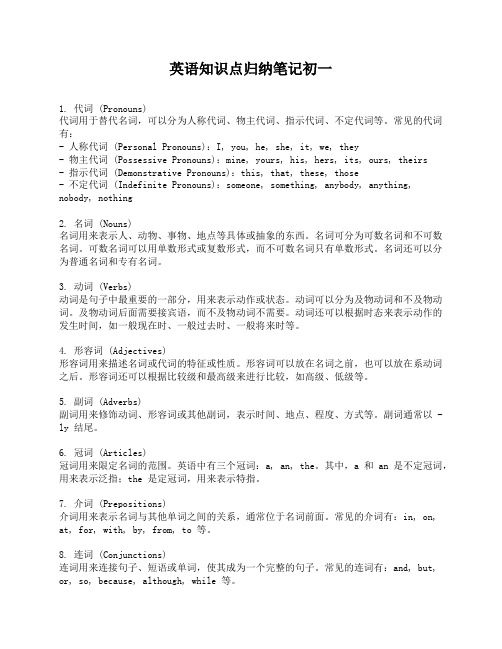
英语知识点归纳笔记初一1. 代词 (Pronouns)代词用于替代名词,可以分为人称代词、物主代词、指示代词、不定代词等。
常见的代词有:- 人称代词 (Personal Pronouns):I, you, he, she, it, we, they- 物主代词 (Possessive Pronouns):mine, yours, his, hers, its, ours, theirs- 指示代词 (Demonstrative Pronouns):this, that, these, those- 不定代词 (Indefinite Pronouns):someone, something, anybody, anything, nobody, nothing2. 名词 (Nouns)名词用来表示人、动物、事物、地点等具体或抽象的东西。
名词可分为可数名词和不可数名词。
可数名词可以用单数形式或复数形式,而不可数名词只有单数形式。
名词还可以分为普通名词和专有名词。
3. 动词 (Verbs)动词是句子中最重要的一部分,用来表示动作或状态。
动词可以分为及物动词和不及物动词。
及物动词后面需要接宾语,而不及物动词不需要。
动词还可以根据时态来表示动作的发生时间,如一般现在时、一般过去时、一般将来时等。
4. 形容词 (Adjectives)形容词用来描述名词或代词的特征或性质。
形容词可以放在名词之前,也可以放在系动词之后。
形容词还可以根据比较级和最高级来进行比较,如高级、低级等。
5. 副词 (Adverbs)副词用来修饰动词、形容词或其他副词,表示时间、地点、程度、方式等。
副词通常以 -ly 结尾。
6. 冠词 (Articles)冠词用来限定名词的范围。
英语中有三个冠词:a, an, the。
其中,a 和 an 是不定冠词,用来表示泛指;the 是定冠词,用来表示特指。
7. 介词 (Prepositions)介词用来表示名词与其他单词之间的关系,通常位于名词前面。
初中英语知识点总结笔记

初中英语知识点总结笔记一、词汇与短语1. 基础词汇- 常见名词:家庭成员、学校科目、日常用品、颜色、数字、天气等。
- 动词:一般现在时、一般过去时、一般将来时的动词变化规则。
- 形容词和副词:描述人、物、地点的特征。
- 代词:人称代词、物主代词、反身代词、指示代词、疑问代词等。
2. 短语- 常见短语动词:look after, take care of, find out, turnoff等。
- 介词短语:in the morning, on the table, by the way, atthe moment等。
- 常用连词:and, but, or, because, if, though, although等。
二、语法1. 时态- 一般现在时:表示经常发生的动作或现在的状态。
- 一般过去时:表示过去发生的动作或状态。
- 一般将来时:表示将来会发生的动作或状态。
- 现在进行时:表示正在进行的动作。
- 过去进行时:表示过去某一时刻正在进行的动作。
- 将来进行时:表示将来某一时刻将要进行的动作。
2. 语态- 被动语态:表示主语是动作的承受者,而非执行者。
- 一般现在时被动语态:am/is/are + past participle。
- 一般过去时被动语态:was/were + past participle。
- 现在进行时被动语态:am/is/are being + past participle。
3. 句型- 陈述句:表达事实或观点。
- 疑问句:提出问题,寻求答案。
- 否定句:表达否定意义。
- 命令句:发出命令或请求。
- 感叹句:表达惊讶、高兴等强烈情感。
4. 非谓语动词- 动名词:作为名词使用,可以作主语、宾语等。
- 分词:现在分词和过去分词,用作形容词或副词。
- 不定式:to + 动词原形,可以作主语、宾语、表语等。
5. 从句- 名词性从句:包括主语从句、宾语从句、表语从句和同位语从句。
初中英语笔记大全

初中英语笔记大全(超级精华版)This is the key to the door .这是开门的钥匙。
⎪⎩⎪⎨⎧电话号码电话号码at .sth .sb callcall sb. = phone sb. = ring sb. upplease give me a call .请打电话给我family 指家庭时是单数,谓语动词用“is ”,family 指家人时是复数,谓语动词用“are ”。
of 表示无生命物体的所有格,s 表示有生命物体的所有格。
有生命物体的所有格也可以用of ,但有生命物体后要加“s ”。
以副词there 或here 开头的句子常要倒装,以示强调。
What’s your name, please = Could you tell me your name, please = May I have your name, pleaseNice to meet you. = Glad to meet you. = Pleased to meet you.写启示的方法:1.启示的主题;2.描述细节;3.留下联系方式。
表示惊讶、忧伤、微怒、失望等,可以用dear 作感叹词。
名词如果有数量词修饰它,使用谓语动词适应看他的数量词,如:⎩⎨⎧keys of sets two are here keysof set a is here get to somewhere (get home 除外)到达…… ⎩⎨⎧)无生命物体的“有”( is there )有生命物体的“有”( have 有 肯定:Let+宾语(人称代词的宾格或名词)+ V 原型+……否定:Don’t let +宾语+V 原型+……/Let + 宾语 + not + V 原型+…… have 表示“有”时才可以用来提问或写成否定“haven’t”。
⎩⎨⎧⋯⋯⋯⋯? you will 问: )听话的人include 不(us Let ? we shall 问: )说话的人和听话的人(include s Let' 联系动词 be 动词+ adj.作表语 感官动词 look 看sound 听smell 闻taste 尝fell 触反身代词:myself (我自己) yourself (你自己) himself (他自己) herself (她自己) itself(它自己) ourselves(我们自己) yourselves(你们自己) themselves(他们自己)How much + be + 商品(答:It’s/They’re……) = What is the price of……(答:It ’s……)cent 美分 One dollar =100 centsother(两者中的另一个) another(三者中的另一个)越接近物品本身性质的形容词越靠近物品,如:big blue hat帮助某人做某事help sb. (to) do sth.help sb. with sth.with the help (n.) of sb. . He studies math well, with the help of teacher.一般将来时的一般形式:主语+will+动词原形+……Can I help you = What can I do for you = (Is there) anything I can do for youwelcomea.受欢迎的v.欢迎n.欢迎get a warm welcome 得到热烈欢迎be动词不加动词原形“hundred,thousand”与基数词一起表示具体数字时不加“s”。
初中英语笔记大全

初中英语笔记大全(超级精华版)This is the key to the door .这是开门的钥匙。
⎪⎩⎪⎨⎧电话号码电话号码at .sth .sb callcall sb. = phone sb. = ring sb. upplease give me a call .请打电话给我family 指家庭时是单数,谓语动词用“is ”,family 指家人时是复数,谓语动词用“are ”。
of 表示无生命物体的所有格,s 表示有生命物体的所有格。
有生命物体的所有格也可以用of ,但有生命物体后要加“s ”。
以副词there 或here 开头的句子常要倒装,以示强调。
What’s your name, please? = Could you tell me your name, please? = May I have your name, please?Nice to meet you. = Glad to meet you. = Pleased to meet you.写启示的方法:1.启示的主题;2.描述细节;3.留下联系方式。
表示惊讶、忧伤、微怒、失望等,可以用dear 作感叹词。
名词如果有数量词修饰它,使用谓语动词适应看他的数量词,如:⎩⎨⎧keys of sets two are here keysof set a is here get to somewhere (get home 除外)到达…… ⎩⎨⎧)无生命物体的“有”( is there )有生命物体的“有”( have 有 肯定:Let+宾语(人称代词的宾格或名词)+ V 原型+……否定:Don’t let +宾语+V 原型+……/Let + 宾语 + not + V 原型+…… have 表示“有”时才可以用来提问或写成否定“haven’t”。
⎩⎨⎧⋯⋯⋯⋯? you will 问: )听话的人include 不(us Let ? we shall 问: )说话的人和听话的人(include s Let' 联系动词 be 动词+ adj.作表语 感官动词 look 看sound 听smell 闻taste 尝fell 触反身代词:myself (我自己) yourself (你自己) himself (他自己) herself (她自己) itself(它自己) ourselves(我们自己) yourselves(你们自己) themselves(他们自己)How much + be + 商品?(答:It’s/They’re……) = What is the price of……?(答:It ’s……)cent 美分 One dollar =100 centsother(两者中的另一个) another(三者中的另一个)越接近物品本身性质的形容词越靠近物品,如:big blue hat帮助某人做某事help sb. (to) do sth.help sb. with sth.with the help (n.) of sb. . He studies math well, with the help of teacher. 一般将来时的一般形式:主语+will+动词原形+……Can I help you? = What can I do for you? = (Is there) anything I can do for you?welcomea.受欢迎的v.欢迎n.欢迎get a warm welcome 得到热烈欢迎be动词不加动词原形“hundred,thousand”与基数词一起表示具体数字时不加“s”。
九年级上册英语重点笔记

九年级上册英语重点笔记一、Unit 1 How can we become good learners?1. 重点单词。
- textbook(教科书;课本)- conversation(交谈;谈话),have a conversation with sb.(与某人交谈)- aloud(大声地;出声地),区别于loud(大声的,形容词,常用来修饰名词,如a loud voice)和loudly(大声地,副词,含有喧闹之意)。
- pronunciation(发音;读音)- sentence(句子)- patient(有耐心的;病人),be patient with sb.(对某人有耐心)- expression(表达(方式);表示)2. 重点短语。
- by doing sth.(通过做某事),例如:I learn English by reading English books.(我通过读英语书学习英语。
)- make mistakes(犯错误),make a mistake也可。
- look up(查阅;抬头看),通常指在词典等资料中查找信息,如look up the word in the dictionary(在词典里查这个单词)。
- take notes(做笔记)- be born with(天生具有),例如:He is born with a good memory.(他天生记忆力好。
)- pay attention to(注意;关注),to是介词,后面接名词、代词或动名词,如pay attention to your pronunciation(注意你的发音)。
3. 重点句型。
- What about doing sth.?(做某事怎么样?)用于提出建议,例如:What about listening to English songs?(听英语歌曲怎么样?)- How do you study for a test?(你如何为考试而学习?)- I study by working with a group.(我通过小组合作来学习。
初中英语笔记(精华版)

初中英语笔记大全(精华版)● This is the key to the door .这是开门的钥匙。
● ⎪⎩⎪⎨⎧电话号码电话号码at .sth .sb call call sb. = phone sb. = ring sb. upplease give me a call .请打电话给我● family 指家庭时是单数,谓语动词用“is ”,family 指家人时是复数,谓语动词用“are ”。
● of 表示无生命物体的所有格,s 表示有生命物体的所有格。
有生命物体的所有格也可以用of ,但有生命物体后要加“s ”。
● 以副词there 或here 开头的句子常要倒装,以示强调。
● What’s your name, please? = Could you tell me your name, please? = May I have your name, please? ● Nice to meet you. = Glad to meet you. = Pleased to meet you.● 写启示的方法:1.启示的主题;2.描述细节;3.留下联系方式。
● 表示惊讶、忧伤、微怒、失望等,可以用dear 作感叹词。
● 名词如果有数量词修饰它,使用谓语动词适应看他的数量词,如:⎩⎨⎧ keys of sets two are here keysof set a is here● get to somewhere (get home 除外)到达……● ⎩⎨⎧)无生命物体的“有”(is there )有生命物体的“有”( have 有 ● 肯定:Let+宾语(人称代词的宾格或名词)+ V 原型+……否定:Don’t let +宾语+V 原型+……/Let + 宾语 + not + V 原型+……● have 表示“有”时才可以用来提问或写成否定“haven’t”。
● ⎩⎨⎧⋯⋯⋯⋯? you will 问: )听话的人include 不(us Let ? we shall 问: )说话的人和听话的人(include s Let'myself (我自己) yourself (你自己) himself (他自己) herself (她自己) itself (它自己) ourselves (我们自己) yourselves (你们自己) themselves (他们自己)● How much + be + 商品?(答:It’s/They’re……) = What is the price of ……?(答:It ’s ……) ● cent 美分 One dollar =100 cents● other(两者中的另一个) another (三者中的另一个)● 越接近物品本身性质的形容词越靠近物品,如:big blue hat●帮助某人做某事help sb. (to) do sth.help sb. with sth.with the help (n.) of sb. e.g. He studies math well, with the help of teacher.●一般将来时的一般形式:主语+will+动词原形+……●Can I help you? = What can I do for you? = (Is there) anything I can do for you?●“hundred,thousand”与基数词一起表示具体数字时不加“s”。
初中英语笔记大全+超级精华版

初中英语笔记大全(超级精华版)● This is the key to the door .这是开门的钥匙。
●call sb. = phone sb. = ring sb. upplease give me a call .请打电话给我● family指家庭时是单数,谓语动词用“is”,family指家人时是复数,谓语动词用“are”。
● of表示无生命物体的所有格,s表示有生命物体的所有格。
有生命物体的所有格也可以用of,但有生命物体后要加“s”。
● 以副词there或here开头的句子常要倒装,以示强调。
● What’s your name, please? = Could you tell me your name, please? = May I have your name, please?● Nice to meet you. = Glad to meet you. = Pleased to meet you.● 写启示的方法:1.启示的主题;2.描述细节;3.留下联系方式。
● 表示惊讶、忧伤、微怒、失望等,可以用dear作感叹词。
● 名词如果有数量词修饰它,使用谓语动词适应看他的数量词,如:● get to somewhere (get home除外)到达……●● 肯定:Let+宾语(人称代词的宾格或名词)+ V原型+……否定:Don’t let +宾语+V原型+……/Let + 宾语 + not + V原型+……● have表示“有”时才可以用来提问或写成否定“haven’t”。
●●联系动词be动词+ adj.作表语感官动词look 看sound 听smell 闻taste 尝fell 触● 反身代词:myself(我自己) yourself(你自己) himself(他自己) herself(她自己) itself(它自己) ourselves(我们自己) yourselves(你们自己)themselves(他们自己)● How much + be + 商品?(答:It’s/They’re……) = What is the price of……?(答:It ’s……)● cent 美分 One dollar =100 cents● other(两者中的另一个) another(三者中的另一个)● 越接近物品本身性质的形容词越靠近物品,如:big blue hat● 帮助某人做某事help sb. (to) do sth.help sb. with sth.with the help (n.) of sb. e.g. He studies math well, with the help of teacher.● 一般将来时的一般形式:主语+will+动词原形+……● Can I help you? = What can I do for you? = (Is there) anything I can do for you?●● be动词不加动词原形● “hundred,thousand”与基数词一起表示具体数字时不加“s”。
- 1、下载文档前请自行甄别文档内容的完整性,平台不提供额外的编辑、内容补充、找答案等附加服务。
- 2、"仅部分预览"的文档,不可在线预览部分如存在完整性等问题,可反馈申请退款(可完整预览的文档不适用该条件!)。
- 3、如文档侵犯您的权益,请联系客服反馈,我们会尽快为您处理(人工客服工作时间:9:00-18:30)。
初中英语精华笔记大全This is the key to the door .这是开门的钥匙。
call sb. =phone sb. = ring sb. upplease giveme a call .请打电话给我family指家庭时是单数,谓语动词用“is”,family指家人时是复数,谓语动词用“are”。
of表示无生命物体的所有格,s表示有生命物体的所有格。
有生命物体的所有格也可以用of,但有生命物体后要加“s”。
以副词there或here开头的句子常要倒装,以示强调。
What’s your name, please? = Could you tell meyour name, please? = May I have your name, please?Nice to meet you. = Glad to meet you. =Pleased to meet you写启示的方法:启示的主题;2.描述细节;3.留下联系方式。
表示惊讶、忧伤、微怒、失望等,可以用dear作感叹词。
名词如果有数量词修饰它,使用谓语动词适应看他的数量词,如:get to somewhere (get home除外)到达……肯定:Let+宾语(人称代词的宾格或名词)+ V原型+……否定:Don’t let +宾语+V原型+……/Let + 宾语+ not + V原型+……have表示“有”时才可以用来提问或写成否定“haven’t”。
反身代词:myself(我自己)yourself(你自己)himself(他自己)herself(她自己)itself(它自己)ourselves(我们自己)yourselves(你们自己)themselves(他们自己)How much + be + 商品?(答:It’s/They’re……)= What is the price of……?(答:It ’s……)cent 美分One dollar =100 centsother(两者中的另一个) another(三者中的另一个)越接近物品本身性质的形容词越靠近物品,如:big blue hat帮助某人做某事help sb. (to) do sth.help sb. with sth.with the help (n.) of sb. e.g. He studies math well, with the help ofteacher.一般将来时的一般形式:主语+will+动词原形+……Can I help you? = What can I do for you? =(Is there) anything I can do for you?be动词不加动词原形“hundred,thousand”与基数词一起表示具体数字时不加“s”。
hundreds of 上百thousands of 上千buy sth. for sb. = buy sb.(间接宾语)sth.(直接宾语)为某人买某物any body 在肯定句中表示任何人,在否定句和疑问句中不是。
for表示动词的对象或接受者,表示用途,表示目的,表示等价交换或标注价格,表示时间持续多久,表示距离,表示理由或原因。
There are many trees on each side of the road There are many trees on both sides of the roadthe price is low(high) 价格低(高)on a cold morning 在一个寒冷的早晨持续一段时间的节日一般用“festival”.kind of ……有几分……如:The elephants are kind of cute.含有think的宾语从句中如果从句中有否定,要否定前移,如:She doesn’t think they are boring.(她认为他们不无聊)问:How are you?答:I’m fine. (我很好。
)/Just so so.(一般般。
)表示时间、价格、距离的名词作主语,谓语动词用单数。
如:Two dollarsis enough(足够)。
怎么判断双音节单词中第一个音节是开音节还是闭音节:双音节单词中的两个元音是两个音节的中心,元音是由元音字母或元音字母组合发出的音,因此,首先找到单词中的两个元音字母或元音字母组合,两个中心就清楚了。
两个中心之间的辅音字母(不是字母组合)则分别划归两个音节,第一个音节即为闭音节,如果两个中心之间的辅音字母为双写字母(包括“r”),分别划归前后,第一个音节按闭音节读音。
如:paper /’peipə/ (pa为开音节) member/’membə/ (mem 为闭音节) happy /’hæpi/ (hap为闭音节) sorry /’sɔri/ (sor为闭音节) certainly /’sə:tnil/I am sorry. I can’t go with you. (对不起。
我不能和你一起去。
)Thanks. / Thank you. / Thank you very much. /Thank a lot. / Many thanks.You are welcome. / That’s OK. / That’s allright. It’s my pleasure. / With pleasure. (这是我的荣幸。
)make friend with sb. (和……交朋友)Thanks for + n. / v.ing = Thanks sb. for + n./ v.ing below 在……下方(非正下方)反义词:above 在……上面(非正上方,没有接触面)under 在……下面(正下方)反义词:on(有接触面),over(没有接触面)在……上面(正上方)keep + sth. + adj. 使某物保持某状态。
keep + adj. 保持某状态。
表示请求、建议、希望得到对方肯定回答的疑问句用“some”。
问:Let……答:OK. / All right. / That’s a good idea. / That sounds good. / Sorry.sport用来修饰名词要变为sports。
play + the + 乐器Erhu除外be动词后叫表语,修饰名词叫定语,修饰动词叫状语,前后两词对等叫同位语。
人民币和日元变复数不变,其他要。
be good with sb. = get on well with sb. 与某人相处的很好问:How often does Rick run on weekend?答:Rick usually runs on weekend.always(总是)usually(通常)often(经常)sometime(有时)seldom(很少)never(从不)频度副词放在be动词或助动词之后,实意动词或行为动词之前。
感叹句:What + (a/an) + adj. + n. + (主) + (谓)!如:What beautiful flowers they are!How + adj. /adv. + (主)+ (谓)!如:How beautiful the flowers are!Can you think what his job is? 含有宾语从句的复合句,宾语从句的从句必须是陈述句。
Start to do sth. 开始做某事be famous for……因……出名for + 时间段……做某事持续多久问:How long do you have volleyball?答:I have volleyball for two hours.ask sb. some questions. 问某人一些问题ask sb. to do sth. 叫某人做某事no =not anybecause不和so同时使用,although(尽管)不和but同时使用。
either:两者中的任何一个都行。
neither:两者中的任何一个都不。
用“may”提问的句子回答用can/can‘t或must / mustn’t;用“can”提问的句子回答用can/can’t;用“must”提问的句子回答用need/needn’t.如:1. May I park my car here?Yes, you can / must. / No, youcan’t / mustn’t.2. Can I watch TV?Yes, you can. / No, you can’t.3. Must I clean the classroomthis morning?Yes, you need. / No, youneedn’t.be afraid of doing sth. / be afraid of sth. 害怕做某事/某物be fond of = likemake a continuation to sth. 对……有贡献do well in = be good at 擅长……比较级+ and + 比较级越来越……give back = return 归还法国人单数:Frenchman/Frenchwoman英国人单数:Englishman/EnglishwomanChinese和Japanese单复数同形in the world 在世界上all over the world / around the world / the whole word 全世界in the school 在学校里 in school 在学校学习outside 在……外面outside the gate to the park 在公园门外turning 转角go down + ……沿着……路走go straight down + ……沿着……路直走enjoy doing sth. 喜欢做某事enjoy oneself = have a good time = have fun take a walk = go for a walk = have a walkthe beginning of ……的开始at the beginning of 强调在……开始的那一刻in the beginning 起初,一开始from the beginning 开始时from beginning to end 从开始到结束visit + 地点、参观某地a visit to + 地点、参观某地have fun doing sth. 做……很开心地点+ is a great place to do sth. ……是一个做……的地方be busy with sth. 忙于某事the way to ……去……的路on the way to + 地点在去……的路上on one’s way to + 地点某人在去……的路上on my way to home 在我回家的路上主语+ hope(that) + 从句主语+ hope + to do sth.live on ……靠……为生between 两者之间among 三者或三者以上之间Why not do sth. ?表建议:为什么不做……呢?Why don’t you do sth. ? 表疑问:你为什么不要……?如:People like this kind of animals, because they’re kind of cute.in the south of 在……南部asleep 睡着的adj. fall asleep 入睡be asleep 正睡着be friendly to sb. 对某人友好don’t forget to do sth. 不要忘记做某事tell sb. to do sth. 叫某人去做某事tell sb. not to do sth. 叫某人不去做某事介词+ doing sth.would like to do sth. 想要做某事Which place do you live in = Where do youlive ? Isn’t he cute ? 否定疑问句Sam wants to play basketball, doesn’t he ? 翻译疑问句Why not do sth. ? = Why don’t you do sth. ? practice doing sth. 练习做某事use sth. to do sth.比较级中的代词用that ,如:The map of Beijing is better than that of Tianjin.said to oneself 自言自语be careful not to do sth. 小心别做某事do one’s best 尽某人的全力be satisfied with……对……满意be full of 满是……条件状语从句:主语为将来时,从句为一般现在时。
